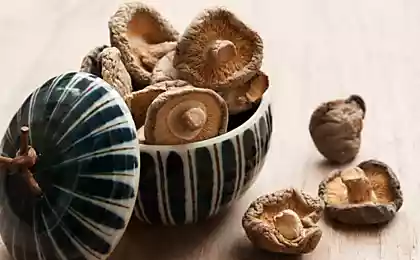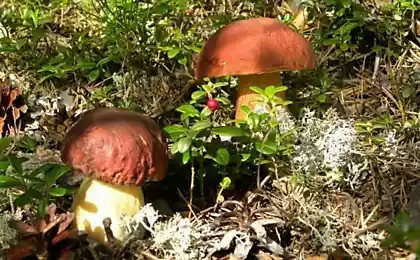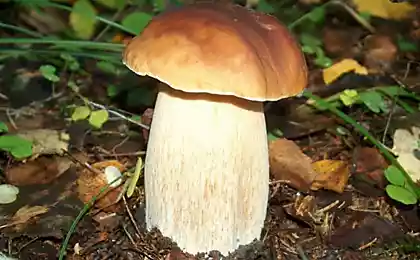679
How to avoid poisoning poisonous mushrooms
There's an old grim joke: "if All the mushrooms you can eat? All. But some only once".

In fact, the poisoning poisonous mushrooms pose a serious danger. Which, however, is not so difficult to avoid. And now, in the season of gathering of forest gifts, it's time to talk about how to distinguish edible from inedible, and even more poisonous.
The first way, simple and reliable
I grew up in a family of avid hunters, and in the woods for mushrooms I have to take, probably, years 5. Then the parents taught me the rule which I adhere to still. And their children also taught: in the forest, only take what you know, what is sure. Nothing new, by the way — the phrase "In dubio abstine" ("In doubt, abstain") from the time of Ancient Rome became winged and in different ways repeated by many great — from generals to writers. I think not a sin to follow the centuries-tested advice...
I understand that some may be disappointed that corny! Be patient, we'll get to ways more difficult. And yet — a few words of caution.
Why is it important to avoid all sorts of dubious gifts of the forest? Though, because of some "noble" mushrooms are very dangerous for the health (and even life!) counterparts. And not always even experienced mushroom will be able at once to recognize them. The fact that the same fungus under different conditions can have different appearance. So, for example, looks "classic" white fungus of the spruce forest (photos mostly not mine — some of them from the Internet):
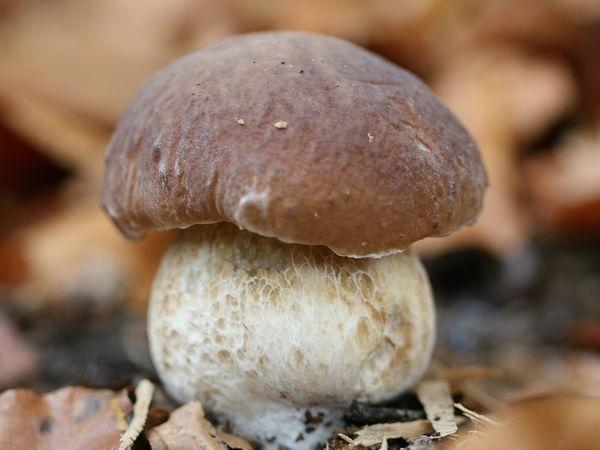
But other form — Boletus pinophilus, boletus edulis pine

And there's a white fungus oak, birch, dark bronze (or of hornbeam) and a great many other forms — early, Arctic, sladkovicova, olive-brown, lemon yellow and so on... each species — their habitats; many of them are on the territory of our country are not found at all. But found (and not so rare) bile inedible mushroom:

This though will not cause serious health problems, but the appetite is spoiled for sure: gall fungus is very bitter, and when cooked the bitterness does not disappear, but rather increases. A distinctive feature of the "werewolf" — pink tubular layer under the bonnet. But the young mushrooms it may be white. As well as the flesh of the fungus on the cut — may be red, but maybe not. A more reliable sign — dark mesh on the leg (in contrast to the bright — white). But for the novice mushroom picker and it is far from clear. So if there is any suspicion it is better just not to put the mushroom in the basket is more expensive. Moreover, among twins, there is such an option:
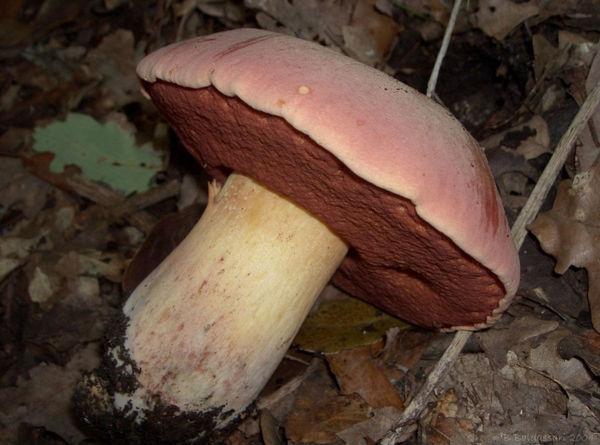
It's a real devil. Poisonous, toxic properties it is little studied, and conduct research on their own health is strongly not recommended. Can be recognized by reddish on the cut of the flesh (though sometimes it can turn blue, so that the sign is not 100% reliable). Adult fungus red tube layer under the cap; the lower part of the legs and the veins on the leg can also be red. But they can not be...
I hope I have convinced you that caution and reasonable prudence is needed the mushroom quality. Let's see, how else can you avoid the danger of poisoning.
The second way, the extreme Eksperimentalnaya second place, since the Council is "to taste a questionable mushroom" there are very, very often. Say I have a poisonous plant you will immediately feel an unpleasant taste — bitter, sharp, pungent. Well what can I say...
First, I doubt very much that licking or chewing a small piece of mushroom, it's safe to make a conclusion about its edibility. No doubt — in the examples above in this way it is possible to distinguish gall from the white mushroom. But among the edible mushrooms there are, the pulp or juice which has a bitter or acrid taste. For example, the same volnushki.

By the way, I was very amused by one book (translated from German), which says that volnushki pink (Lactarius torminosus) is a poisonous mushroom. The authors, however, specify that "the people of Eastern Europe know how to make it edible using lactic acid fermentation". But about the culinary subtleties later. And raw is really absolutely inedible — not worth it.
Even some Russula are tangy in taste that is not, however, a sign they are inedible. And even more unlikely you will be able to thus be 100% sure that you are addressing a lady, not like her toadstool.
Secondly, experiments of this kind is perfectly safe to call still difficult. No, from microscopic dose of venom, most likely, no one will go to the other world. But do tell me, to compare "taste", for example, gourmet mushrooms...

... with the deadly poisonous Amanita ocreata (white mushroom) or Amanita phalloides (pale toadstool)?

They say that North Americans these mushrooms are called "angels of death". You still want to try?..
Among other things, to distinguish such toadstool can and eye: first, the characteristic tuberous thickening in the lower part of the leg — the root. Secondly, the color of the plates under the cap: the mushroom they are pink, darkening with time; grebes — always white.
In General, my advice is: if you want to avoid poisoning poisonous mushrooms — never try to taste it to determine their degree of edibility.
The third way, kollektivnykh own experience is not enough, but there is a friend mushroom, which all the forest knows "face and name" — boldly to him for advice about any questionable instance. But there are nuances...
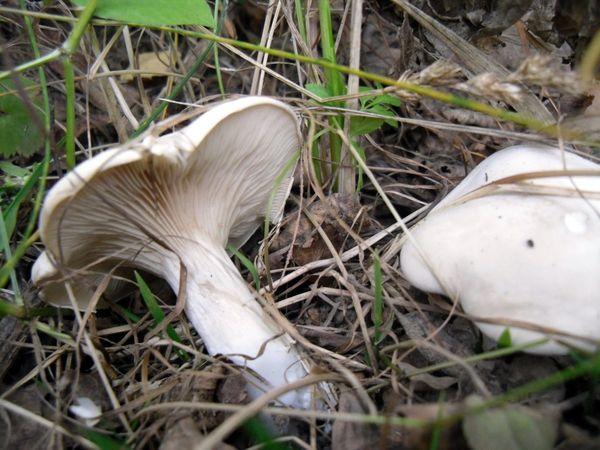
Above I mentioned the fact that many do not consider: the same mushroom in different conditions may look different. So that proper identification can require description the place where the discovery was made, is the first.
Second — to be determined the fungus to be delivered to your expert in safe and sound, in the fullest form. This is important because some types and forms, it is possible to identify with certainty only on the aggregate number of external signs.
Finally, it is necessary to consider local traditions. The same fungus where it is considered edible, and no one takes believing that it is unsuitable in food. I had one funny incident with the mushrooms.

I accustomed since childhood that the oiler needs to be a white film that covers the lower part of the cap. Adult fungus it breaks, but its traces remain in the form of a visible ring on the stem. The cap of this oiler on top of dark, glossy. Already much later I learned that this is suillus luteus (Suillus luteus), but there are other forms.
These nuances were unknown to me at the time, when I looked at the unfamiliar forest mushrooms, very similar to old acquaintances, but for some reason without even a hint of film. Yes, and hats have the pale... But it was well, very much edible, so I decided I should get to consult with local mushroom pickers.

Those categorically stated: boletus. And in my timid question, where is the film, puzzled, asked what is this film :) it Turns out that my usual price and there are extremely rare, and nobody takes because somehow strange looks...
The mushroom note: all varieties of edible oil belong to the tubular fungi. If the inner surface of the cap is not porous, similar to a dense sponge, and plate — in front of you in any case don't greasers!
And then there are the mushrooms with the controversial, that is to say, reputation. Let's say we have never collected pig, considering them inedible. Only as an adult, I learned that they, it appears, and fry and for pickling use. According to modern research, it turns out that svinushek can lay down and still record in non-edible mushrooms as discovered their ability with regular eating to destroy red blood cells (to death inclusive — but this is how much those svinushek to eat?!).

In General, if you are familiar with the mushroom, know how to cook it, convinced of its edibility (and this viewpoint is backed by real experience) — don't listen to what they say about him other. But do not experiment, if in doubt: in the forest full of mushrooms, which are certainly edible, and it makes no sense to endanger your health by collecting those that you personally are not sure.
For example, I remained dubious mushrooms and blewits, and Govorushko — although I lived where they grow a lot, and the locals are willing to collect and prepare these mushrooms. But among the same radovac is as edible (and delicious!), and poisonous species. And with each of his "prey" to the neighbors will not run...
The fourth way, kulinarnayakniga mushrooms become edible only after a very specific kind of treatment. For example, the already mentioned volnushki delicious in a salt form, but not dry or freeze them should not be. And before salting, it is recommended to pre-soak and boil. The same applies to other mlechnikov, for example, the black penny.
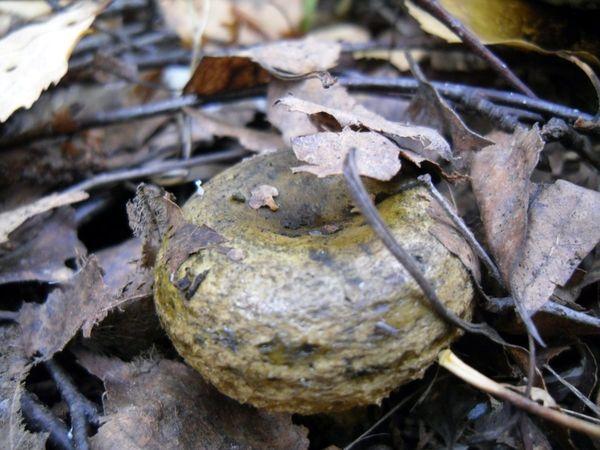
But the same source that classifies the fungi poisonous mushrooms read: recent studies have shown that the composition of the penny black there are substances which have a carcinogenic effect (i.e. can cause cancer). If they are destroyed during cooking — an open question. As the question of whether to abandon the delicious salty Gruzdkov...
There is a rather large category of fungi, which are called conditionally edible. That is, under appropriate cooking methods to eat it can be, but the body's reaction to it is difficult to predict. And in any case should not eat these mushrooms raw. Conditionally edible are considered to be the same pig, which have already been discussed. Treat them well as the lurid bolete, valuy, Morel edible and others.
All types of honey are recommended subjected to strong thermal processing. By the way, many believe honey is a true delicacy, but eating them without the risk, should learn to confidently distinguish between true and false types. Given the diversity of experience (summer, autumn, winter, meadow, etc.), they deserve a separate discussion, so here we consider in detail this subject will not.
Interesting "cooking" example — beetle. We rarely eat, but the majority of species of this mushroom is edible, including the white beetle that shown in the photo.

Only here there is one "but": beetle gray (and according to some, and coprinus micaceus) is a mushroom exclusively for teetotalers, because combined with the alcohol cause a severe allergic reaction (it can manifest palpitations, indigestion, poor circulation). The effect can occur even if the mushrooms have been eaten for a couple of days before drinking the fatal glass.
Finally, we should not forget that poison can even edible mushrooms. It is possible if to eat old, overripe or worm-eaten mushrooms they accumulate toxins that can lead to intestinal disorders of varying severity. But the greatest danger fraught with canned mushrooms: if you violate the rules of their preparation or storage in the banks begin to proliferate anaerobic bacteria that produce the deadly botulinum toxins.
At the disposal of doctors there are effective treatments against botulism, but if the help was rendered untimely, alas, very likely fatal. Get the bacteria in the workpiece due to insufficient processing of raw materials, and their development is triggered by not sufficient acid medium (I use vinegar or salt), careless cooking (too lazy to cook properly) or improper storage (kept the banks with mushrooms warm).
The method of the fifth, obrazovatelnyh it's simple: the more types of mushrooms we are able to accurately recognize, the greater will be the basket :) If you like mushrooms and want to diversify their mushroom menu, don't be lazy to search more about them, learn to identify growing in your area. Edible mushrooms a lot more than people think.

And yet, going back to what had started the conversation. Going into the woods to pick mushrooms, don't forget about the very first and main rule — do not collect and do not eat what is not assured. published
Source: www.7dach.ru

In fact, the poisoning poisonous mushrooms pose a serious danger. Which, however, is not so difficult to avoid. And now, in the season of gathering of forest gifts, it's time to talk about how to distinguish edible from inedible, and even more poisonous.
The first way, simple and reliable
I grew up in a family of avid hunters, and in the woods for mushrooms I have to take, probably, years 5. Then the parents taught me the rule which I adhere to still. And their children also taught: in the forest, only take what you know, what is sure. Nothing new, by the way — the phrase "In dubio abstine" ("In doubt, abstain") from the time of Ancient Rome became winged and in different ways repeated by many great — from generals to writers. I think not a sin to follow the centuries-tested advice...
I understand that some may be disappointed that corny! Be patient, we'll get to ways more difficult. And yet — a few words of caution.
Why is it important to avoid all sorts of dubious gifts of the forest? Though, because of some "noble" mushrooms are very dangerous for the health (and even life!) counterparts. And not always even experienced mushroom will be able at once to recognize them. The fact that the same fungus under different conditions can have different appearance. So, for example, looks "classic" white fungus of the spruce forest (photos mostly not mine — some of them from the Internet):

But other form — Boletus pinophilus, boletus edulis pine

And there's a white fungus oak, birch, dark bronze (or of hornbeam) and a great many other forms — early, Arctic, sladkovicova, olive-brown, lemon yellow and so on... each species — their habitats; many of them are on the territory of our country are not found at all. But found (and not so rare) bile inedible mushroom:

This though will not cause serious health problems, but the appetite is spoiled for sure: gall fungus is very bitter, and when cooked the bitterness does not disappear, but rather increases. A distinctive feature of the "werewolf" — pink tubular layer under the bonnet. But the young mushrooms it may be white. As well as the flesh of the fungus on the cut — may be red, but maybe not. A more reliable sign — dark mesh on the leg (in contrast to the bright — white). But for the novice mushroom picker and it is far from clear. So if there is any suspicion it is better just not to put the mushroom in the basket is more expensive. Moreover, among twins, there is such an option:

It's a real devil. Poisonous, toxic properties it is little studied, and conduct research on their own health is strongly not recommended. Can be recognized by reddish on the cut of the flesh (though sometimes it can turn blue, so that the sign is not 100% reliable). Adult fungus red tube layer under the cap; the lower part of the legs and the veins on the leg can also be red. But they can not be...
I hope I have convinced you that caution and reasonable prudence is needed the mushroom quality. Let's see, how else can you avoid the danger of poisoning.
The second way, the extreme Eksperimentalnaya second place, since the Council is "to taste a questionable mushroom" there are very, very often. Say I have a poisonous plant you will immediately feel an unpleasant taste — bitter, sharp, pungent. Well what can I say...
First, I doubt very much that licking or chewing a small piece of mushroom, it's safe to make a conclusion about its edibility. No doubt — in the examples above in this way it is possible to distinguish gall from the white mushroom. But among the edible mushrooms there are, the pulp or juice which has a bitter or acrid taste. For example, the same volnushki.

By the way, I was very amused by one book (translated from German), which says that volnushki pink (Lactarius torminosus) is a poisonous mushroom. The authors, however, specify that "the people of Eastern Europe know how to make it edible using lactic acid fermentation". But about the culinary subtleties later. And raw is really absolutely inedible — not worth it.
Even some Russula are tangy in taste that is not, however, a sign they are inedible. And even more unlikely you will be able to thus be 100% sure that you are addressing a lady, not like her toadstool.
Secondly, experiments of this kind is perfectly safe to call still difficult. No, from microscopic dose of venom, most likely, no one will go to the other world. But do tell me, to compare "taste", for example, gourmet mushrooms...

... with the deadly poisonous Amanita ocreata (white mushroom) or Amanita phalloides (pale toadstool)?

They say that North Americans these mushrooms are called "angels of death". You still want to try?..
Among other things, to distinguish such toadstool can and eye: first, the characteristic tuberous thickening in the lower part of the leg — the root. Secondly, the color of the plates under the cap: the mushroom they are pink, darkening with time; grebes — always white.
In General, my advice is: if you want to avoid poisoning poisonous mushrooms — never try to taste it to determine their degree of edibility.
The third way, kollektivnykh own experience is not enough, but there is a friend mushroom, which all the forest knows "face and name" — boldly to him for advice about any questionable instance. But there are nuances...

Above I mentioned the fact that many do not consider: the same mushroom in different conditions may look different. So that proper identification can require description the place where the discovery was made, is the first.
Second — to be determined the fungus to be delivered to your expert in safe and sound, in the fullest form. This is important because some types and forms, it is possible to identify with certainty only on the aggregate number of external signs.
Finally, it is necessary to consider local traditions. The same fungus where it is considered edible, and no one takes believing that it is unsuitable in food. I had one funny incident with the mushrooms.

I accustomed since childhood that the oiler needs to be a white film that covers the lower part of the cap. Adult fungus it breaks, but its traces remain in the form of a visible ring on the stem. The cap of this oiler on top of dark, glossy. Already much later I learned that this is suillus luteus (Suillus luteus), but there are other forms.
These nuances were unknown to me at the time, when I looked at the unfamiliar forest mushrooms, very similar to old acquaintances, but for some reason without even a hint of film. Yes, and hats have the pale... But it was well, very much edible, so I decided I should get to consult with local mushroom pickers.

Those categorically stated: boletus. And in my timid question, where is the film, puzzled, asked what is this film :) it Turns out that my usual price and there are extremely rare, and nobody takes because somehow strange looks...
The mushroom note: all varieties of edible oil belong to the tubular fungi. If the inner surface of the cap is not porous, similar to a dense sponge, and plate — in front of you in any case don't greasers!
And then there are the mushrooms with the controversial, that is to say, reputation. Let's say we have never collected pig, considering them inedible. Only as an adult, I learned that they, it appears, and fry and for pickling use. According to modern research, it turns out that svinushek can lay down and still record in non-edible mushrooms as discovered their ability with regular eating to destroy red blood cells (to death inclusive — but this is how much those svinushek to eat?!).

In General, if you are familiar with the mushroom, know how to cook it, convinced of its edibility (and this viewpoint is backed by real experience) — don't listen to what they say about him other. But do not experiment, if in doubt: in the forest full of mushrooms, which are certainly edible, and it makes no sense to endanger your health by collecting those that you personally are not sure.
For example, I remained dubious mushrooms and blewits, and Govorushko — although I lived where they grow a lot, and the locals are willing to collect and prepare these mushrooms. But among the same radovac is as edible (and delicious!), and poisonous species. And with each of his "prey" to the neighbors will not run...
The fourth way, kulinarnayakniga mushrooms become edible only after a very specific kind of treatment. For example, the already mentioned volnushki delicious in a salt form, but not dry or freeze them should not be. And before salting, it is recommended to pre-soak and boil. The same applies to other mlechnikov, for example, the black penny.

But the same source that classifies the fungi poisonous mushrooms read: recent studies have shown that the composition of the penny black there are substances which have a carcinogenic effect (i.e. can cause cancer). If they are destroyed during cooking — an open question. As the question of whether to abandon the delicious salty Gruzdkov...
There is a rather large category of fungi, which are called conditionally edible. That is, under appropriate cooking methods to eat it can be, but the body's reaction to it is difficult to predict. And in any case should not eat these mushrooms raw. Conditionally edible are considered to be the same pig, which have already been discussed. Treat them well as the lurid bolete, valuy, Morel edible and others.
All types of honey are recommended subjected to strong thermal processing. By the way, many believe honey is a true delicacy, but eating them without the risk, should learn to confidently distinguish between true and false types. Given the diversity of experience (summer, autumn, winter, meadow, etc.), they deserve a separate discussion, so here we consider in detail this subject will not.
Interesting "cooking" example — beetle. We rarely eat, but the majority of species of this mushroom is edible, including the white beetle that shown in the photo.

Only here there is one "but": beetle gray (and according to some, and coprinus micaceus) is a mushroom exclusively for teetotalers, because combined with the alcohol cause a severe allergic reaction (it can manifest palpitations, indigestion, poor circulation). The effect can occur even if the mushrooms have been eaten for a couple of days before drinking the fatal glass.
Finally, we should not forget that poison can even edible mushrooms. It is possible if to eat old, overripe or worm-eaten mushrooms they accumulate toxins that can lead to intestinal disorders of varying severity. But the greatest danger fraught with canned mushrooms: if you violate the rules of their preparation or storage in the banks begin to proliferate anaerobic bacteria that produce the deadly botulinum toxins.
At the disposal of doctors there are effective treatments against botulism, but if the help was rendered untimely, alas, very likely fatal. Get the bacteria in the workpiece due to insufficient processing of raw materials, and their development is triggered by not sufficient acid medium (I use vinegar or salt), careless cooking (too lazy to cook properly) or improper storage (kept the banks with mushrooms warm).
The method of the fifth, obrazovatelnyh it's simple: the more types of mushrooms we are able to accurately recognize, the greater will be the basket :) If you like mushrooms and want to diversify their mushroom menu, don't be lazy to search more about them, learn to identify growing in your area. Edible mushrooms a lot more than people think.

And yet, going back to what had started the conversation. Going into the woods to pick mushrooms, don't forget about the very first and main rule — do not collect and do not eat what is not assured. published
Source: www.7dach.ru
